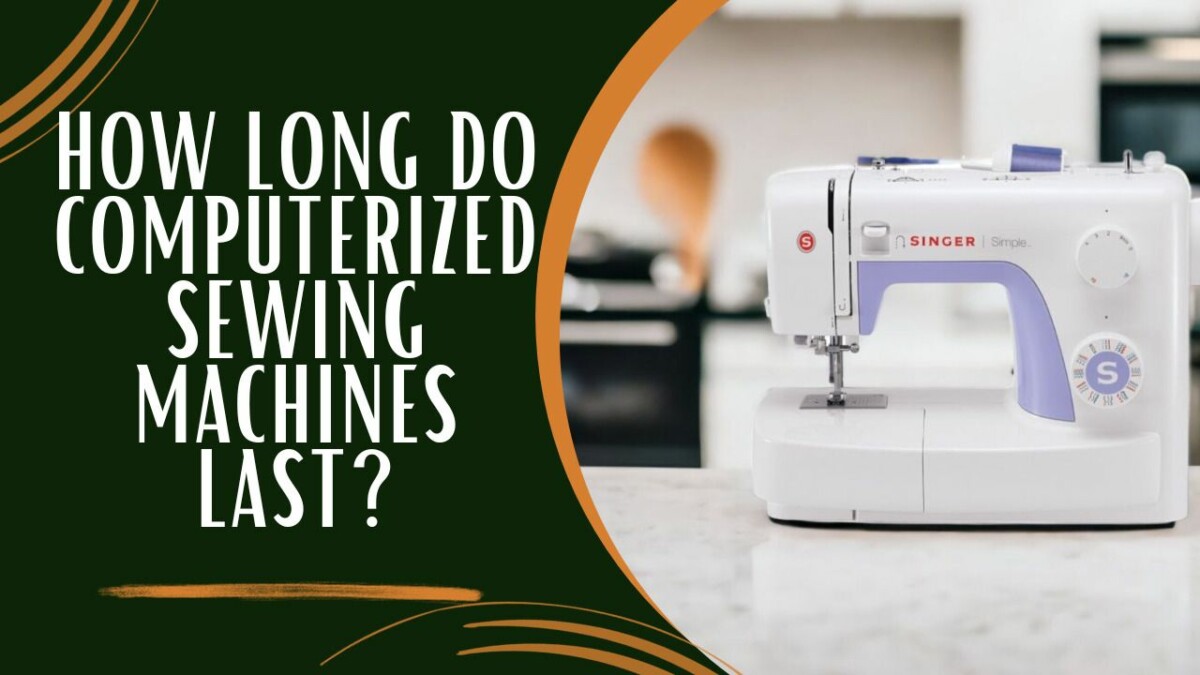Just like that car you love so much, your computerized sewing machine also needs some regular love and care to keep it running smoothly.
You might be thinking, ‘how long is this thing going to last?’ Well, it’s not a straightforward answer. The lifespan of your machine is influenced by a bunch of factors like how frequently you use it, how well you maintain it, and whether it’s up to date with the latest tech.
Sure, the mechanical parts might hold up longer than the computerized ones, but both parts definitely require some TLC.
But hey, don’t stress! With the right care, your machine could easily last you more than a decade.
Now, let’s take a deep dive into the factors that affect your sewing machine’s life expectancy.
How Long Can I Expect My Computerized Sewing Machine to Last?
Computerized sewing machines can last anywhere between 5 to 25 years or more if you use them properly and take good care of them, much depends on the model quality.
When it comes to the lifespan of your tech-savvy sewing machine, remember, it’s not a one-size-fits-all situation. A lot depends on factors like how much you use it, how well you look after it, and how fast technology changes. For example, if you’re constantly putting your machine through its paces without showing it some TLC, you’re probably gonna shorten its life. Regular maintenance is a must-do, not a maybe.
It’s also worth noting the speed at which technology races ahead. If your machine can’t keep up with the latest software and systems, it might become obsolete before you know it. That’s why it’s important to stay on top of tech trends. They play a huge role in how long your computerized sewing machine sticks around for.
Comparing Lifespan: Mechanical Vs. Computerized Parts in Sewing Machines
When it comes to the lifespan of sewing machine parts, you’re definitely gonna notice a pretty big difference between the mechanical and computerized bits and pieces. If you’re weighing up the lifespan of the old school mechanical parts versus the high-tech computerized ones, it’s a no-brainer. The mechanical parts pretty much always outlive the computerized ones.
So, let’s talk about mechanical parts. These bad boys are tough as nails. If you take good care of them, they’re going to last you a good long while.
On the flip side, you’ve got the computerized parts. These can be a bit of a pain. Technology moves fast, so sometimes you might need to replace them to keep up. Plus, they can also get worn out.
When you’re comparing the durability of mechanical versus computerized parts, here’s what you need to know:
Durability-wise, mechanical parts win hands down. They’re built to last.
As for maintenance, regular TLC can help both types last longer.
When it comes to replacing parts, the computerized ones can be a bit tricky to find and swap out.
At the end of the day, how long your machine lasts isn’t just about the parts. It’s about how you use it and how well you maintain it. So, keep that in mind!
The Role of Compatibility in the Longevity of Computerized Sewing Machines
Soon enough, you’ll realize that compatibility isn’t just some nerdy tech term, it’s a game changer when it comes to the life of your computerized sewing machine. Don’t just brush it off. The whole software update thing? Yeah, it can make or break your machine’s survival in the long run. As the tech world keeps on advancing, your machine needs to keep up. If updates don’t jive with your machine, it might start acting all wonky.
So, when you’re out shopping for a machine, don’t just think about now. Keep the future in mind too. Go for a model that has a track record of rolling with the tech punches. Keep in mind, a machine that can’t keep up with the latest software updates could become outdated faster than you can say ‘thread the needle.’
Compatibility isn’t just about making your life easier right now. It’s about future-proofing your machine. So, when you’re buying, think ahead. Don’t just buy for the here and now, think long-term.
Repairability and Its Impact on the Lifespan of Computerized Sewing Machines
Listen up, the lifespan of your sewing machine is directly tied to its repairability, so don’t sleep on this crucial factor. The relentless march of tech advancements can throw a spanner in the works when it comes to repairs. Let’s break it down:
- *Figuring out what’s wrong*: You need to play detective here. You can’t sort out a problem if you don’t know what it is.
- *Hunting down spare parts*: This can be like finding a needle in a haystack. As tech rockets forward, getting hold of parts for older models becomes more of a mission.
- *Technical expertise*: Finding a whizz who can handle repairs on older models is no small feat, thanks to the tech evolution.
- *Weighing up repair costs*: Sometimes, fixing your machine could cost an arm and a leg, more than the machine itself. You might find it’s better to just bite the bullet and get a new one.
- *Repair timeline*: Time is money, and the longer your machine is on the fritz, the more your sewing schedule suffers.
Opting for a machine that’s easy to fix can be a game-changer for its lifespan. So, make your choice wisely.
How Annual Maintenance Can Extend the Life of Your Computerized Sewing Machine
Making a habit of giving your computerized sewing machine a yearly check-up can really help it live a long and productive life. Trust me, you don’t want to underestimate the power of a regular tune-up. It keeps your machine in tip-top shape, guaranteeing every stitch comes out just right. Plus, it lowers the chances of any damage from regular wear and tear.
So, let’s talk about some ways to take care of your tech-savvy sewing machine. First off, after you’re done with your sewing session, give your machine a good clean. Get rid of all the lint and dust from any part of the machine you can reach. And when it comes to the thread, don’t skimp on quality. High-grade thread won’t leave behind as much lint.
Also, remember to keep all the moving parts well-oiled, just follow what the manual tells you. And don’t sleep on those software updates. They’re super important for maintaining the high-tech functions of your machine. It might seem like a lot of effort, but trust me, it’s worth it. Spending a little time on care now can save you a bunch of money on repairs in the future.
Discover More About Sewing Machines and Their Lifespan!
If you are intrigued by the question, “How Long Do Computerized Sewing Machines Last?”, then you might also be curious about the lifespan of different brands of sewing machines. Specifically, if you find yourself wondering about how long Singer sewing machines last, then you’re in luck – there’s a whole resource for that! You can discover the lifespan and durability of Singer models and how it stacks up against other brands!
But hey, let’s switch gears for a moment. It’s not all about the shiny new toys. If you’re fascinated by the charm and heritage of older models, you surely must have asked yourself, what’s the value of antique sewing machines? Well, turns out there’s a whole realm of old-school machines waiting for your discovery, where you can find out how much those vintage beauties go for and what makes them so coveted by sewists.
And if you’re passionate about quilting and looking for the right tool for the job, there’s one brand that might have caught your attention – Bernina. Ever questioned if Bernina sewing machines are good for quilting? Let’s shed some light on this matter. Discover if Bernina models are worth the investment and how they elevate the art of quilting.
So, whether you’re sewing, quilting, or just browsing, there is always something new to uncover in the dynamic world of sewing machines.
I graduated from London College of Fashion, and I’ve been working for a Fashion Design company for 10 years. My other hobbies are going to the gym and reading.







